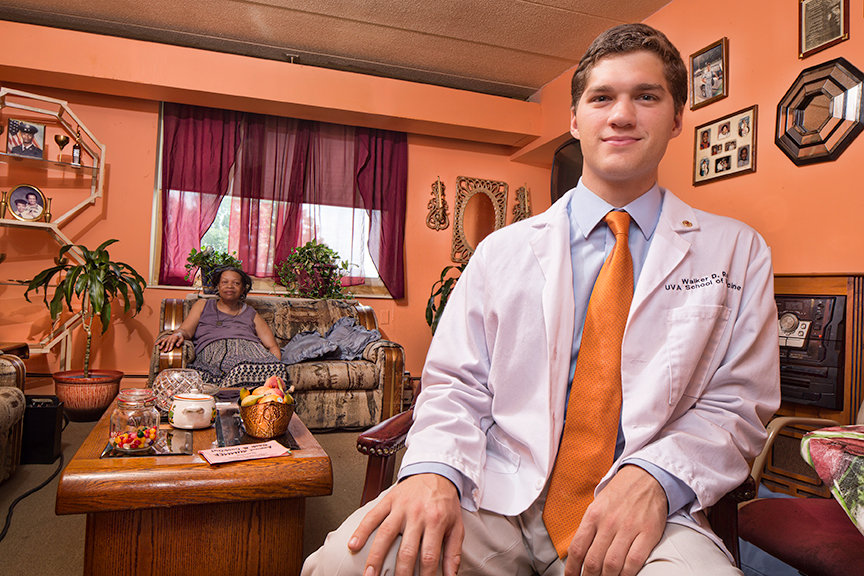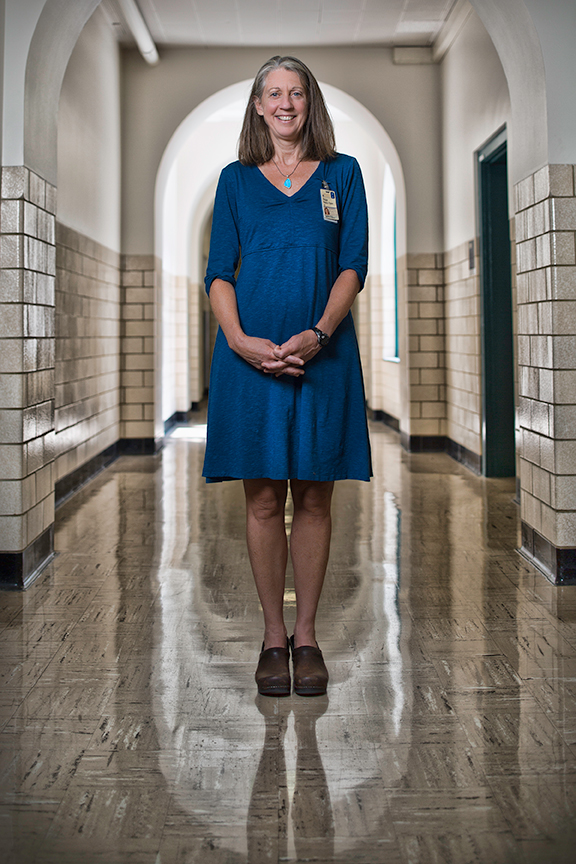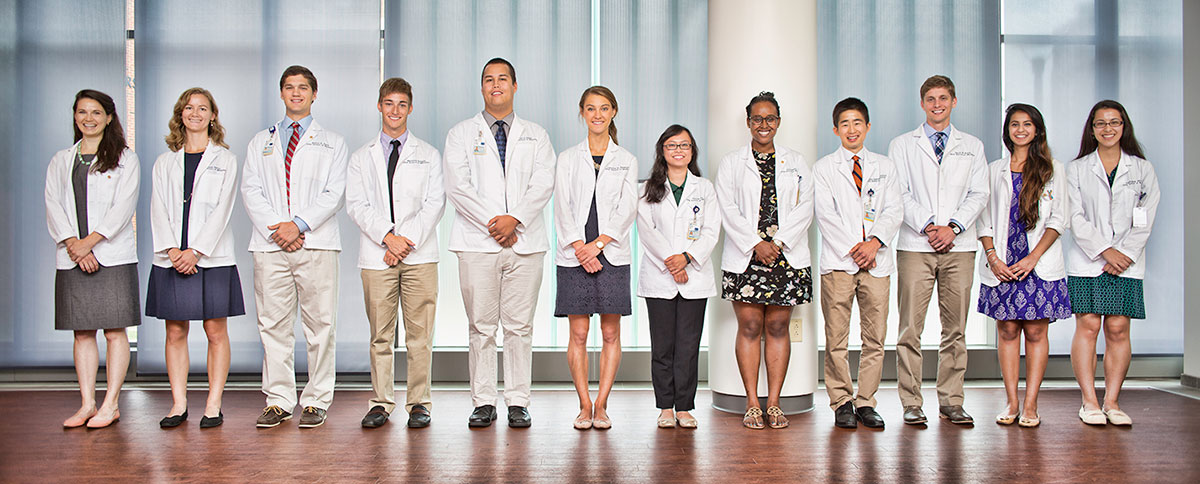Walker Redd remembers distinctly his first encounter with a patient as a University of Virginia medical student. This was not, however, the typical first-year assignment, to get a simple medical history from a hospitalized patient. This was a house call, for starters. And the patient was complex; she had multiple sclerosis, diabetes, a history of cancer and multiple complications as a result of the MS, including blindness. There were social issues, too. And the assignment was simply to get to know this person.
“I remember thinking, ‘OK, so my patient is blind,’” Redd said. “We were in her apartment and she showed us around. She was so happy to have us there. And I sat there and had a conversation with her, which I will never forget.”

Part of the Phronesis Project involves students like Walker Redd making house calls to local patients. (All photos by Jackson Smith)
The Question of Wisdom
So what does wisdom mean in the field of medicine? That has been the focus for Dr. Margaret Plews-Ogan, a UVA professor of medicine and founder of the Phronesis Project, for the last several years. With research support from the Templeton Foundation and other sources, Plews-Ogan is trying to understand how wisdom works to make the world – specifically the world of medicine – a better place.

“What we do in medical training for the most part has to do with fostering knowledge,” Margaret Plews-Ogan said. “But we don’t pay a whole lot of attention to how students apply that knowledge.”
It’s these qualities that Plews-Ogan arrives at when she tries to get at this concept of “wisdom.” And it’s these qualities that the Phronesis Project attempts to cultivate in medical students.
More than Knowledge
“When I started thinking about how do we foster wisdom in medical students, I realized we don’t,” Plews-Ogan said. “What we do in medical training for the most part has to do with fostering knowledge. But we don’t pay a whole lot of attention to how students apply that knowledge.”
Most of this application of knowledge happens in the third and fourth years of medical school, when students work with physician mentors to develop more advanced clinical skills. While students rotate through clerkships in medicine, surgery, pediatrics and other specialties learning to diagnose and treat patients, they also pick up attitudes and habits from the attending and resident physicians with whom they work – attitudes and habits that may not represent the ideal.
One of the main goals of the Phronesis Project is to circumvent this “hidden curriculum,” as it is often referred to, by providing students the opportunity to learn the art of medicine through real, long-term relationships with patients and physician mentors from the very beginning of medical school. Plews-Ogan hopes that by fostering characteristics of wisdom in this context, students will be able to identify and decide for themselves what they want to bring to the bedside as physicians.
Developing the Capacity
The Phronesis Project kicked off in September 2014. Twelve students from that incoming class were invited to volunteer for this pilot that takes place within the Clinical Practice Development class, in which groups of six students meet with a faculty mentor one afternoon a week. In addition to learning how to do a physical exam, interviewing patients and engaging in discussions about ethical dilemmas and how culture affects health care, these 12 students also participate in the Phronesis curriculum.
Students are assigned to follow an adult patient who is selected because he or she has some ongoing medical challenge, such as a chronic illness. They are also matched with a pediatric patient who similarly is dealing with physical and social difficulties that make them medically complex. And rather than limiting their interactions to meetings in the clinic, students also visit patients in their homes.
“The idea is to have students see the patient as a person, rather than their disease,” said Natalie May, a co-investigator in Plews-Ogan’s wisdom research. “When med students see patients in the clinic, they see the patient is late, she didn’t take her meds, she didn’t take a five-mile walk every day as she was told to do. But when a student sees Ms. Jones in her home, they see that she’s a grandmother, that she’s funny, that she used to be a schoolteacher and won a teacher-of-the-year award. So she’s no longer ‘the diabetic.’ They start to see this person’s perspective.”
Patients as the Focus
For Walker Redd, it was this emphasis on relationships with patients that made him want to voluntarily commit to a minimum of two extra hours a week to be part of this project. On that first home visit he did along with Plews-Ogan, he conducted a semi-structured narrative interview designed to elicit the patient’s perspective on her health and how it affects her life.
“The idea is to see the whole person,” Redd said. “You already have the medical history in the electronic medical record, so you know that. This is allowing an hour or two for someone to tell you their life story and to see what they think is significant to include. It was a good way for me to learn a lot about my patient and also for her to feel like she was comfortable sharing with me.”
“The idea is to have students see the patient as a person, rather than their disease. When a student sees Ms. Jones in her home, they see that she’s a grandmother, that she’s funny, that she used to be a schoolteacher and won a teacher-of-the-year award. So she’s no longer ‘the diabetic.’" - Natalie May
Over the course of the first year, Redd went with his patient to several medical appointments and was present when she had a bone marrow biopsy. He visited her home on another occasion to discuss smoking cessation, and he calls her occasionally just to check in.
“Those phone calls have been helpful for both of us,” Redd said. “For me I want to make sure she’s doing OK, and she appreciates checking in with me. We swap stories or talk about sports; we’re both big sports fans.”
Because first- and second-year students have not yet developed clinical skills, the focus for Phronesis participants in those early years is on the physician as advocate and partner in health and wellness. Monthly after-hours meetings at Plews-Ogan’s home offer the opportunity for informal discussions about ideas such as advocacy, developing behavioral goals with patients and the nuances of forming relationships. These skills are then cultivated in a real-life context with patients.
New Teaching Methods Needed
Fostering wisdom, however, is not as simple as turning students loose with a patient of their own. Trying to instill qualities such as self-awareness, an appreciation for ambiguity and a willingness to look at things from different points of view requires an ongoing, multidimensional approach that works both directly and indirectly.
“You can’t teach someone to be compassionate by telling them to do it,” Plews-Ogan said by way of example. “It’s something that is fostered from the inside out.”
The Phronesis Project uses some unconventional teaching methods in an attempt to achieve its goals. Storytelling, for example. Plews-Ogan suggested that this is one way for students to try to see things differently, to cause a shift in a situation or someone’s thinking, a way to return to a place of compassion and empathy.
Similarly, reflective writing is an important practice that can foster not only self-reflection, but also cognitive capacities such as discovering the deeper meaning of an experience.
As Phronesis students move into the clerkship phase of the curriculum, Plews-Ogan hopes to develop experiences that will support and foster wisdom in other ways. One idea that’s brewing is creating a space where all medical students gather, a room where they can hang out, maybe with a couple attending physicians, and talk about that patient whose symptoms don’t make sense or that social challenge that makes it hard for the patient to comply with a treatment plan.
“That kind of across-the-table, informal sharing of ideas is one way that you can help students understand that a lot of medicine is these gray, vexing situations,” Plews-Ogan said, “that you need to turn things over and talk to someone about it, scratch your head and say, ‘What about this?’”
The pilot project is only beginning its second year, so it’s too early to tell what impact this focus on wisdom in a medical school curriculum will have on new young doctors. For Walker Redd, however, being part of this project has already had a profound impact.
“I think I would have struggled more in my first year without Phronesis,” he says. “I remember Dr. Plews-Ogan, as she was dropping me off after that first house call, she said, ‘Welcome to what doctoring is’ – which was incredibly empowering, because as a med student, patients seem so far away. With the tediousness of the work leading up to the clerkship years, you lose track of, ‘Oh, I’m doing this for patients, for real people.’ Being part of Phronesis has helped me refocus my intentions, my goals, what I came to medicine for in the first place.”
Media Contact
UVA Medical Alumni Association and Medical School Foundation
lct6r@virginia.edu 434-924-2346
Article Information
January 7, 2016
/content/teaching-wisdom-phronesis-project-brings-practical-wisdom-medical-school

